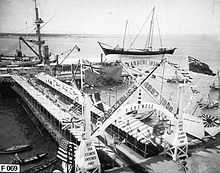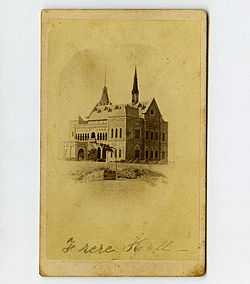Demographic history of Karachi
The Demographic history of Karachi of Sindh, Pakistan. The city of Karachi grew from a small fishing village to a megacity in last 175 years.
The Late Palaeolithic and Mesolithic sites found by Karachi University team on the Mulri Hills, in front of Karachi University Campus, constitute one of the most important archaeological discoveries made in Sindh during the last fifty years. The last hunter-gatherers, who left abundant traces of their passage, repeatedly inhabited the Hills. Some twenty different spots of flint tools were discovered during the surface surveys.
Karachi was known to the ancient Greeks by many names: Krokola, the place where Alexander the Great camped to prepare a fleet for Babylonia after his campaign in the Indus Valley; Morontobara (probably Manora island near Karachi harbour), from whence Alexander's admiral Nearchus set sail; and Barbarikon, a port of the Bactrian kingdom. It was later known to the Arabs as Debal from where Muhammad bin Qasim led his conquering force into South Asia in AD 712.[1]
Karachi was reputedly founded as "Kolachi" by Baloch tribes from Balochistan and Makran, who established a small fishing community in the area.[2] Descendants of the original community still live in the area on the small island of Abdullah Goth, which is located near the Karachi Port. The original name "Kolachi" survives in the name of a well-known Karachi locality named Mai Kolachi in Balochi. Mirza Ghazi Beg, the Mughal administrator of Sindh, is among the first historical figures credited for the development of coastal Sindh (consisting of regions such as the Makran coast and the Indus delta), including the cities of Thatta, Bhambore and Karachi. The ancient names of Karachi included: Krokola, Barbarikon, Nawa Nar, Rambagh, Kurruck, Karak Bander, Auranga Bandar, Minnagara, Kolachi, Morontobara, Kolachi-jo-Goth, Banbhore, Debal, Barbarice and Kurrachee.[3][4]
In the seventeenth century, Karak Bander was a small port on the Arabian Sea on the estuary of the Hub River, 40 km west of present day Karachi. It was a transit point for the South Asian-Central Asian trade. The estuary silted up due to heavy rains in 1728 and the harbour could no longer be used. As a result, the merchants of Karak Bander decided to relocate their activities to what is today known as Karachi. Trade increased between 1729 and 1839 because of the silting up of Shahbandar and Keti Bandar (important ports on the Indus River) and the shifting of their activities to Karachi.[5]
The village that later grew out of this settlement was known as Kolachi-jo-Goth (Village of Kolachi in Sindhi). By the late 1720s, the village was trading across the Arabian Sea with Muscat and the Persian Gulf region. The local Sindhi populace built a small fort, that was constructed for the protection of the city, armed with cannons imported by Sindhi sailors from Muscat, Oman. The fort had two main gateways: one facing the sea, known as Kharra Darwaaza (Brackish Gate) (Kharadar) and the other facing the Lyari River known as the Meet'ha Darwaaza (Sweet Gate) (Mithadar), which correspond to the modern areas of Kharadar and Mithadar.
The name Karachi was used for the first time in a Dutch document of 1742, when a merchant ship de Ridderkerk shipwrecked nearby its coast.[6][7]
The earliest inhabitants of the area that became Karachi were Sindhi tribes such as the Jokhio, Mallaah and Jat in the east and Baloch in the west and. Before the end of British colonial rule and the subsequent independence of Pakistan in 1947, the population of the city was majority Sindhi and Baloch Muslims, Hindus and Sikhs, but the community is still present numbering around 250,000 residents.[8] The city was, and still is home to a large community of Gujarati Muslims who were one of the earliest settlers in the city, and still form the majority in Saddar Town. Important Gujarati Muslim communities in the city include the Memon, Chhipa, Ghanchi, Khoja, Bohra and Tai. Other early settlers included the Marwari Muslims, Parsis originally from Iran, Marathi Muslims and Konkani Muslims from Maharashtra (settled in Kokan Town), Goan Catholics and Anglo-Indians. Most non-Muslims left the city to India in the 1950s, after independence, but there are still small communities of Parsis, Goan Catholics and Anglo-Indians in the city.
The independence of Pakistan in 1947 saw the influx of Muslim Muhajirs from India fleeing from anti-Muslim pograms. Majority of the Urdu speaking and other non-Punjabi Muslim refugees that fled from various states of India settled in Karachi which is why the culture of the city is a blend of South Asia. Most properties vacated by non-Muslims, who left Karachi due to the new settlements made by these refugees, were granted to Muslim refugees through claims on behalf of the properties they claimed of leaving behind in India.[9] Today, the descendants of these Muslim refugees are known as Muhajirs form a powerful large population of Karachi. These Muhajirs include ethno-linguist Urdu, Gujarati, Marathi, Konkani Muslims, Rajasthani and Malabari Muslims from India. Majority of the Gujaratis in Karachi are ethno-linguistically Sindhis; majority of Rajasthani Muslims settled in the city much before the independence of Pakistan in 1947; Bihari of Bangladesh speak Bhojpuri, Bengali Muslims speak Bengali and Rohingya peak Rohingya language. These small ethno-linguist groups are being assimilated in the Urdu speaking community.[9]
Picture gallery
-

A map of Karachi from 1889
-

The Empress Market, 1890
-

A map of Karachi from 1893
-

View of the dense old native town by the end of the 19th century
-

View of the Bunder Road (now M. A. Jinnah Rd.), 1900
-

Bunder Road
-

Farewell arch erected by the Karachi Port for the Royal visit of Prince of Wales, later King George V, 1906
-

British family at Elphinstone St., 1914
-

Frere Hall, Karachi, c1860.
See also
- Ethnic groups in Karachi
- Demographics of Karachi
- Religion in Karachi
- History of Karachi
- Demographics of Sindh
- Demographics of Pakistan
- List of metropolitan areas by population
References
- ↑
- ↑ "DAWN – Features; August 8, 2002". Dawn.Com. 8 August 2002. Retrieved 10 February 2014.
- ↑ Kurrachee: (Karachi) Past, Present and Future
- ↑ A gazetteer of the province of Sindh
- ↑ The case of Karachi, Pakistan
- ↑ The Dutch East India Company (VOC) and Diewel-Sind (Pakistan) in the 17th and 18th centuries, Floor, W. Institute of Central & West Asian Studies, University of Karachi, 1993–1994, p. 49.
- ↑ The Dutch East India Company's shipping between the Netherlands and Asia 1595-1795
- ↑ "Population of Hindus in the World". http://pakistanhinducouncil.org. Retrieved 21 April 2013.
- ↑ 9.0 9.1 "Political and ethnic battles turn Karachi into Beirut of South Asia " Crescent". Merinews.com. Retrieved 24 November 2012.